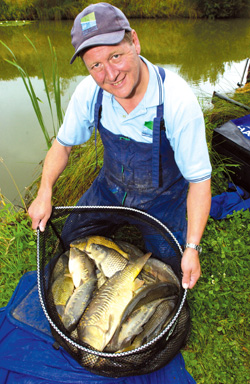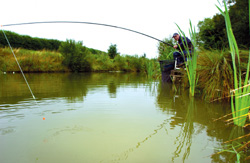Thatchers 2000 skipper MARK HARPER has just the method to avoid those foul hookers and sort out the lumps when you’re fishing in the margins – suspending big lumps of meat up in the water. Match Fishing reveals how it’s done…
I came across a method that helped put more stamp fish in my net when fishing in the margins at venues where there is a big head of small carp and crucians and it helped me win in situations where I might otherwise have failed, writes Mark Harper.
It involves fishing off the bottom which may not sound too revolutionary, but how many anglers do you know who will fish down the side but up in the water? It really can be a devastating match tactic and is really worth trying.
In The Beginning
How it came about for me was that I was having trouble getting bitted out by smaller carp (under 1lb), crucians and brown goldfish while fishing on the bottom in the margins. You can catch these types of fish every chuck, but failing to sort out bigger is often the difference between 30lb for a section win and 70lb for a match win. I needed a way to select the bigger carp. Now, these bigger carp might only be 1lb to 3lb, but compared to three-to-the-pound fish it makes a big difference at the end. On other waters the ‘big’ carp might be 6lb to 8lb, it’s all relative to where you are fishing.
I was also finding that I was foul hooking too many of these smaller fish when fishing on or just touching the bottom, which isn’t good because you spook the fish and tend to lose a lot of them.
One day I started to lift and drop the bait using the full depth rig and quite often enticed a better fish. That was the first step, but then I found that by suspending a bait eight to 10 inches off the bottom I received very positive bites and larger fish. It wasn’t just that the carp were taking it properly, but the way they were doing it – I found they were ripping the elastic out.
So, I thought I’d try it again and sure enough the next time I fished in the margins, once again I found the better carp were lying above the smaller fish and once again they were ripping the elastic out.
With two or three really good matches under my belt, the method was born!
Starting Point
I would advise that you start off fishing the margins with a typical rig to present the bait on the bottom in a more conventional way. But if you start to catch too many smaller carp and you want to sort out the bigger specimens then switch to the shallow rig.
The time to switch is when you start to get loads of bites that you can’t hit from little fish and every decent fish is a foul hooker. These aspects combined, tell me it’s time to go up in the water.
Ideal Depths
I look for at least 18in to 2ft of water in the margins and basically that’s the minimum, so I could end up fishing 9in deep in 18in of water.
I actually like to have two rigs to suspend the baits, one set at half depth and, in 2ft or more, one set to suspend six inches off bottom. Sometimes the latter one is the most effective.
Basically, I feed like I would in an open-water swim when trying to catch shallow – a little but all the time, and that’s if you fish close enough to yourself to be able to feed by hand.
Blob Float
To hold a big bait, like a chunk of the cat meat or an even bigger piece of luncheon meat, off the bottom you need a very buoyant float and I don’t believe bristled patters are any good for this. I am using a blob float, which is a round, fluorescent, poly ball float that the line runs through the middle of. I am actually using a prototype of one of the new range from Preston Innovations.
The poly balls are held in place with locking shot either side, two No12s each side is enough to secure the float at the correct depth. No other shot is required down the line and the bait hangs freely underneath, at the required depth.
 |
| Mark’s poly ball float |
 |
| The float has to be big enough to suspend a lump of meat. |
With the blob float you need to match the size of bait to the size of float so the hook bait doesn’t sink the float. I find that a whole piece of cat meat is just about right on this blob.
The bites really are very positive and often the first thing you know is when the tip of the pole goes round and the elastic shoots out!
What Tackle?
It’s interesting really, most people don’t even think of fishing up in the water in the nearside margins, but they’ll do it against an island or far bank on the long pole. If fish are prepared to swim off the bottom in the far margins then they’ll do the same in the nearside ones, too, so it’s not that unusual for it to work. It’s just something fish in most waters don’t see.
Because it tends to sort out the better fish there’s room for compromise, so 0.17mm diameter Powerline direct to the hook is my starting choice. Where it is allowed, I will use a bait spring or coil – otherwise I’ll use a soft Preston bait arrow to mount the hook bait. That means I get away with a smaller hook and ultimately a better hook hold. The hook is equally strong being an eyed Preston PR27 in a size 14 for the spring rig as it’s fished on a knotless knot set-up, or a PR28 in the same size for an arrow. However, I would use a size 12 PR21 if I was fishing a venue where I had to mount the bait on the hook.
I prefer the original Preston Slip elastics in grade 12 because I am not a believer in heavy elastic. I think you lose too many fish with a strong elastic. The more stick you give a fish, the more it gives you. I’d rather play them on the relatively-soft elastic, even though they take a little longer to get out.
 |
| Mark uses Preston grade 12 elastic. |
The Session
I started this session with double corn on the hook fishing on the bottom and the early fish were as expected, small carp under the 1lb mark.
This is what I found last year when perfecting the method. The other problem is that you start to foul hook them. The feeding differs from traditional margin fishing, which has often been a dump-and-wait scenario where you feed bit pots of bait and wait for fish to arrive.
With my style, I like to drip in feed all the time, for example today I am dripping in corn and pellet alternately – a few offerings of each at a time. This should encourage the bigger fish to look for bait falling through the water.
Bait-wise, when it was working well for me it was with cat meat and larger pieces of luncheon meat, but it can work with other baits, too, like double corn. I feed other, smaller baits like pellets, hemp and casters as they’re great holding baits. If you feed large baits all the while like cat meat or corn, you’ll fill the fish up too quickly. Incidentally, I don’t feed any cat meat or luncheon meat, preferring to loose feed corn and pellet and fish the big target bait over the top.
Within half an hour I am getting lots of indications from the smaller carp, so it’s time to try the shallow rig.
What tends to happen when you first go in – today I dropped in with double corn on the hook first – is that the float will bob around and rattle a bit as the smaller fish mess about with the hook bait. What I try to do, is to keep a tight line to the blob and wait. When a decent fish hits that bait the elastic will scream out. Sometimes with the small fish becoming a nuisance, I would use a big piece of luncheon meat because it is harder than the cat meat that can be too quickly whittled away by the small fish.
If you get a lot of these rattles and bobs without attracting a proper take, it pays to lift out and check the hook bait. If it has been whittled away too much you will have to rebait the hook.
Spring-Time
Where bait springs are allowed, they’re the best thing to use with soft meat baits. I tie my springs up on hooklengths, using the knotless knot to create a hair that I use to attach the spring to. This is why an eyed hook has to be used and I’ve found the best hook is a Preston PR27.
|
|
||||
|
|
||||
|
|
I was soon mounting on a piece of cat meat and, using the spring, it is very easy to do. I just take a piece of cat meat and twist the free end of the spring into the meat. You just twist it like a corkscrew, until all of the spring is inside the meat.
While the Match Fishing cameras were with me, I was catching well on the suspended bait – with the rig set 6in off the bottom proving best on the day.
In less than four hours I managed 50lb to 60lb, so the method is still on song.
 |
| Another big bag of carp for margin maste Mark Harper. |
Knotless knot
If you haven’t used a knotless knot before, here is how I do it: Firstly, I attach the coil to the line using a blood knot. Then I form the knotless knot by passing the free end of the line through the back of the hook eye. You want the hook to rest above the bait, so gauge the distance (or measure it) and hold the hook in place. I then whip down the shank of the hook for eight turns, then pass the loose end of the line back through the back of the eye and pull it tight. This makes the hook stand out from the coil, which leaves the point exposed so the fish hook themselves when they try to eject the bait. To save time on the bank, I prepare lots of these at home and keep them on winders for when I need them.
Venue File
TODBER MANOR
Controlling body: Privately owned commercial fishery
Where situated: Todber, north Dorset
How to find it: From the A30 Sherborne to Shaftesbury road, take the B3092 at East Stour and head south towards Todber. Just after the village of Stour Provost, look out for the right turn towards Fifehead Magdalen. To access the lakes, turn right here and the entrance is on the left after about 100 yards. However, you must visit the Todber Manor tackle shop first, which is the next right turn off the B3092 into Shave Lane. The tackle shop can be found in the courtyard on the left after half a mile
Contact: John Candy on 01258 820384 or 07974 420813












